Pea crab (Pinnotheres pisum) is a tiny sea crab that got its name due to its tiny size, reminiscent of a pea. But the most interesting thing is that it leads an unusual lifestyle: this crab lives inside the body of bivalves, such as mussels and scallops, using their protection and food.
Classification
• Kingdom: Animals (Animalia)
• Phylum: Arthropoda (Arthropoda)
- Class: Crustacea
• Order: Decapoda
- Family: Pinnotheridae
- Genus: Pinnotheres
- Species: Pinnotheres pisum

Appearance
📏 Sizes
- Females: 8-12 mm wide
- Males are even smaller - up to 6 mm
🎨 Color scheme
- Body translucent, light brown or grayish
- The shell is soft, rounded - not as hard as that of most crabs
- The legs are thin and long - they allow easy movement in the body of the mollusk
👁️ Features
- In females, the shell is softer and swollen - adapted to a sedentary lifestyle
- Males are more mobile, mostly staying outside the mollusk
Living environment
🌍 Area
- Atlantic coast of Europe, North Sea, Baltic Sea
- Found off the coasts of the UK, France, Scandinavia, and the Netherlands
🌊 Housing.
- Lives permanently inside bivalves (mussels, scallops, pecten)
- He chooses mollusks that filter water to get food
Behavior
🦪 Lifestyle
- Symbiont or parasite - lives in the gill cavity of a mollusk
- Gets food from particles that are filtered out by the owner
- Does not harm the mollusk directly, but can reduce its nutritional efficiency
🚶 Mobility
- Males are able to leave the mollusk in search of a female or a new "host"
- Females remain permanently in the selected mollusk
Food
🍽️ What he eats
- Small organic particles brought by the water current into the mollusk
- Can also eat mucus and leftover food of the host
❗ Feature
- No need to look for food yourself - all the food comes from the mollusk filtration
Reproduction
🧬 Reproduction
- Males are more active, looking for females to mate with
- After fertilization, the female holds the eggs under her abdomen
- Young fish are initially free-swimming (planktonic), then look for a mollusk to live on
🧒 Kids
- Go through several stages of development (zoea, megalopa)
- After settling, they settle in a new clam
Interesting facts
✔️ The pea crab is a typical example of commensalism or parasitism in the marine world
✔️ Sometimes it can be found inside the harvested mussel during cooking
✔️ Because of its soft shell, it is sometimes called "soft-shell crab"
✔️ It is not used in cooking, although it sometimes accidentally gets into food
Conclusion
The pea crab is an unusual sea creature that breaks our perceptions of crabs. Instead of running around on the seabed, it hides in the shell of a mollusk and uses its resources. Despite its modest size, this crab is an interesting example of adaptation to life in symbiosis. 🦀🐚🔍